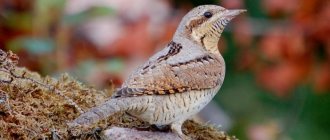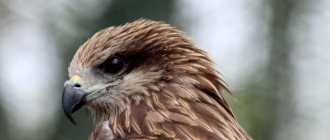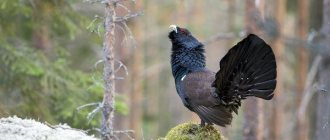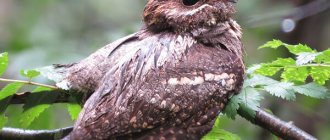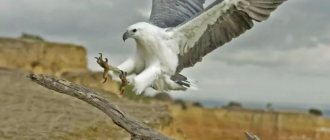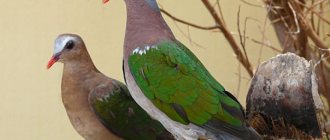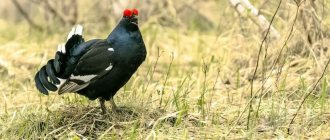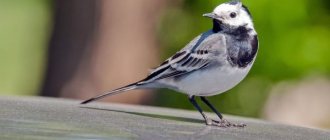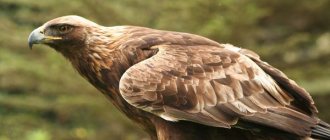The griffon vulture of the genus vulture lives in Central, Asia Minor and Central Asia, southern Europe and northern Africa. The bird also lives in the highlands of eastern Africa and the Arabian Peninsula. The griffon vulture is a predator that eats carrion. Lives and hunts in open mountainous areas at an altitude of up to 400 meters above sea level. Cliffs and rocks are the predator’s favorite habitats.
Griffon vulture (lat. Gyps fulvus)
Appearance
Our vulture has a very powerful and large build, the length ranges from 95 to 115 cm. The head is not proportional to the body and has light plumage, the eyes are moderately small, a thin mobile diaphragm is yellowish-brown, the eyes themselves are gray-brown. The wingspan reaches three meters.
The color of the bird is brown, the underbody is slightly lighter, the legs are dark gray. The beak has a characteristic size and shape of an elongated hook, light gray in color. It should be noted that his neck is elongated and equipped with a chic collar of long feathers, which gives him such an important and businesslike look.
The scavenger's tail has a rounded shape, but is shorter in length than that of its other relatives. The female and the male do not differ from each other in appearance, however, the size of the body and wings, the male slightly predominates. The weight of the bar ranges from 6.6 to 12 kg.
Description
The griffon vulture is a very beautiful and rare bird of Crimea. Often, in good weather, in the mountains you can observe several high-flying birds, as if floating in the space of the sky, which can be distinguished by their light head and dark body. Interesting fact: the griffon vulture is listed in the Red Book , since it is a rare species, and the number in Crimea is only about 150 birds ! The size of griffon vultures is simply enormous; they are one of the largest birds on our peninsula. The body length of birds sometimes corresponds to the height of a small child, and the wingspan can reach two and a half meters! Therefore, even when they soar high in the sky, you can always immediately notice them and admire the beauty of their majestic flight. It was very interesting to hear the voice of birds, so bubbling, with ripples, vaguely reminiscent of a turkey’s cooing.
Griffon vultures are monogamous , forming pairs for years, and also nest in one place for several years. The female lays a single egg in January-February, both partners incubate it for 50–52 days , the chick leaves the nest at three months of age. Therefore, it is very important not to disturb them during the breeding season, so that the birds have the opportunity to increase their population size. Unlike the black vulture, vultures very often nest on rocks, which gives them an advantage over bad weather and other force majeure.
Griffon Vulture
Group flight
Wingspan up to 2 - 2.5 meters
Range and habitat
The griffon vulture has a wide range and is distributed both on the European, African and Western continents. On the territory of modern Russia, this species lives in the Crimea and the Caucasus. Also, he lives in the countries of Central and Central Asia:
- Kazakhstan;
- Kyrgyzstan;
- Tajikistan;
- State in India Assam;
If you go beyond the continents, you can find it on the islands of the Mediterranean Sea:
- Crete;
- Cyprus;
- Sicily;
- Sardinia;
On the African continent, this bird species has settled in the north-west of the country in the coastal zones of Morocco and Tunisia.
- Maned wolf
- Nettle
- Elk
- 100 facts about bears
- Jungle animals
- Saber-toothed tiger
Physiology [edit]
Vultures have been used as model organisms to study hovering and thermoregulation. The energy cost of level flight is typically high, which encourages larger birds to use an alternative to flapping. Vultures, in particular, use more efficient flight methods such as hovering. Compared to other birds, which have a 16-fold increase in metabolic rate in flight, [30] soaring vultures expend approximately 1.43 times their basal metabolic rate in flight. Griffon vultures are also efficient fliers in their ability to return to their resting heart rate after flying for ten minutes. [31]
As large scavengers, vulture vultures do not seek shelter to thermoregulate. Vultures use their bald heads as a means of thermoregulation at both very low and high temperatures. Changing your posture can increase the effect on bare skin from 7% to 32%. This change allows convective heat losses in still air to more than double. [32] Griffon vultures also tolerate elevated body temperatures in response to high environmental temperatures. By allowing core body temperature to vary independently of metabolic rate, vultures minimize water and energy loss during thermoregulation. [33]One study in particular (Bahat, 1995) found that these adaptations allowed the vulture vulture to have one of the widest thermal neutral zones of any bird. [34]
Lifestyle
The vulture bird leads a sedentary lifestyle, often nests on slopes and hills, in rock cracks, etc. A male and a female create a pair for many years, both parents participate in incubating the offspring and subsequently raising them.
Favorite places to live are dry and open spaces on hills and mountains. This is so that you can take off comfortably. In the mountains it prefers to live at an altitude of up to three thousand meters above sea level; it looks for food (dead bodies or carcasses of animals) around the perimeter of its nesting area, but can fly even higher.
This bird could well live higher, but at altitudes of more than 5,000 thousand meters there is no food in sufficient quantities. The fact is that the vulture bird tries to live in those areas where there is a massive concentration of cattle. And, as we know, it does not rise above 3,500 thousand meters.
Having a large body, the bird has difficulty taking off from a flat surface of the earth. Catching the flow of warm air with its huge wings, it slowly rises upward. The wingspan is rare but deep.
The bird can make hoarse croaking sounds, but does this very rarely, but it is considered the most vocal individual than other birds of this species.
Interesting Facts
- Griffon vultures are orderlies in mountainous regions. They eat the corpses of animals and gnaw their meat so diligently that not a single piece remains on the bones where dangerous pathogenic microorganisms could multiply. Sometimes barn owls become so overwhelmed with carrion that they lose the ability to take off. In these cases, the bird regurgitates part of the eaten carrion, thus getting rid of ballast. Today, food for griffon vultures and other species of vultures is becoming less and less available.
- Before taking off from the surface of the earth, the vulture needs a very long acceleration, but from a rock ledge the bird takes off very easily, after several beats of its wings. That is why in the habitats of the vulture there must be hills that are convenient for takeoff.
- During rain or thick fog, barn owls do not fly and always wait out bad weather in their nests.
Nutrition
The struggle between a vulture and a wolf for prey.
Like all vultures, they feed on carrion and waste that people leave for them. Early in the morning the bird is in no hurry to fly out to hunt; the vulture waits until the air warms up to the required temperature. Soaring at an altitude of more than 800 meters, he carefully examines places where dead cattle may be located.
Thanks to its good eyesight, it often focuses on large concentrations of other scavengers. Among these bird species, there is a real hierarchy and each species has its own role. Our hero in this chain is the most important.
When a group of birds discovers a dead animal, they try to wait until the griffon vulture arrives and opens the belly of the dead mammal with its sharp and long beak. Then he sticks his head into the womb of the dead artiodactyl and begins to eat everything from the inside, only sometimes pulling out the head along with the intestines.
It does not eat wool, skin or tendons, so it does not leave pellets. In this regard, birds of this species have to regurgitate leftover food from time to time.
Having waited for the main character to fill his womb, other relatives get down to business, quickly turning the carcass into a gnawed skeleton. They can become so full that they cannot fly. You have to regurgitate some of the food to become a little lighter and then take off.
Noteworthy: it can go without food for a long time .
Excerpt characterizing the Griffon Vulture
- Here's what, brothers. I know it’s difficult for you, but what can you do? Be patient; not long left. Let's see the guests out and then rest. The king will not forget you for your service. It’s difficult for you, but you’re still at home; and they - see what they have come to,” he said, pointing to the prisoners. - Worse than the last beggars. While they were strong, we did not feel sorry for ourselves, but now we can feel sorry for them. They are people too. Right, guys? He looked around him, and in the persistent, respectfully perplexed glances fixed on him, he read sympathy for his words: his face became lighter and lighter from an senile, meek smile, wrinkled like stars in the corners of his lips and eyes. He paused and lowered his head as if in bewilderment. - And even then, who called them to us? Serves them right, m... and... in g.... - he suddenly said, raising his head. And, swinging his whip, he galloped, for the first time in the entire campaign, away from the joyfully laughing and roaring cheers that upset the ranks of the soldiers. The words spoken by Kutuzov were hardly understood by the troops. No one would have been able to convey the content of the field marshal’s first solemn and, at the end, innocently old man’s speech; but the heartfelt meaning of this speech was not only understood, but that same, that very feeling of majestic triumph, combined with pity for the enemies and the consciousness of one’s rightness, expressed by this, precisely this old man’s, good-natured curse - this very (feeling lay in the soul of every soldier and was expressed by a joyful cry that did not cease for a long time. When after this one of the generals turned to him with a question about whether the commander-in-chief would order the carriage to arrive, Kutuzov, answering, unexpectedly sobbed, apparently being in great excitement. November 8th is the last day of the Krasnenskys battles; it was already dark when the troops arrived at the place where they spent the night. The whole day was quiet, frosty, with light, sparse snow falling; in the evening it began to become clearer. Through the snowflakes, a black-purple starry sky could be seen, and the frost began to intensify. The musketeer regiment leaving Tarutino numbering three thousand, now, numbering nine hundred people, he was one of the first to arrive at the appointed place for the night, in a village on the high road. The quartermasters who met the regiment announced that all the huts were occupied by sick and dead Frenchmen, cavalrymen and staff. There was only one hut for the regimental commander. The regimental commander drove up to his hut. The regiment passed through the village and placed the guns on the goats at the outer huts on the road. Like a huge, multi-membered animal, the regiment set to work organizing its lair and food. One part of the soldiers scattered, knee-deep in the snow, into the birch forest that was to the right of the village, and immediately the sound of axes, cutlasses, the crackling of breaking branches and cheerful voices were heard in the forest; the other part was busy around the center of the regimental carts and horses, placed in a pile, taking out cauldrons, crackers and giving food to the horses; the third part scattered in the village, setting up headquarters rooms, selecting the dead bodies of the French lying in the huts, and taking away boards, dry firewood and straw from the roofs for fires and wattle fences for protection. About fifteen soldiers behind the huts, from the edge of the village, with a cheerful cry, were swinging the high fence of the barn, from which the roof had already been removed. - Well, well, together, lie down! - voices shouted, and in the darkness of the night a huge fence covered with snow swayed with a frosty crack. The lower stakes cracked more and more often, and finally the fence collapsed along with the soldiers pressing on it. There was a loud, crudely joyful cry and laughter. - Take two at a time! bring the horn here! that's it. Where are you going? - Well, at once... Stop, guys!.. With a shout! Everyone fell silent, and a quiet, velvety pleasant voice began to sing a song. At the end of the third stanza, at the same time as the end of the last sound, twenty voices cried out in unison: “Uuuu!” It's coming! Together! Pile on, kids!..” But, despite the united efforts, the fence moved little, and in the established silence one could hear heavy panting. - Hey you, sixth company! Devils, devils! Help us... we will also come in handy. Of the sixth company, about twenty people who were going to the village joined those dragging them; and the fence, five fathoms long and a fathom wide, bending, pressing and cutting the shoulders of the puffing soldiers, moved forward along the village street. - Go, or what... Fall, Eka... What happened? This and that... The funny, ugly curses did not stop. - What's wrong? – suddenly the commanding voice of a soldier was heard, running towards the carriers. - Gentlemen are here; in the hut he himself was anal, and you, devils, devils, swearers. I'll! – the sergeant major shouted and hit the first soldier who turned up in the back with a flourish. – Can’t you be quiet? The soldiers fell silent. The soldier who had been hit by the sergeant-major began, grunting, to wipe his face, which he had torn into blood when he stumbled upon a fence. - Look, damn, how he fights! “My whole face was bleeding,” he said in a timid whisper when the sergeant-major left. - Don’t you love Ali? - said a laughing voice; and, moderating the sounds of voices, the soldiers moved on. Having got out of the village, they spoke again just as loudly, peppering the conversation with the same aimless curses. In the hut, past which the soldiers passed, the highest authorities had gathered, and over tea there was a lively conversation about the past day and the proposed maneuvers of the future. It was supposed to make a flank march to the left, cut off the viceroy and capture him. When the soldiers brought the fence, kitchen fires were already flaring up from different sides. Firewood crackled, snow melted, and the black shadows of soldiers scurried back and forth throughout the occupied space trampled in the snow. Axes and cutlasses worked from all sides. Everything was done without any orders. They hauled firewood for the night's reserves, erected huts for the authorities, boiled pots, and stored guns and ammunition. The fence dragged by the eighth company was placed in a semicircle on the north side, supported by bipods, and a fire was laid out in front of it. We broke the dawn, made calculations, had dinner and settled down for the night by the fires - some mending shoes, some smoking a pipe, some stripped naked, steaming out lice. It would seem that in those almost unimaginably difficult conditions of existence in which Russian soldiers found themselves at that time - without warm boots, without sheepskin coats, without a roof over their heads, in the snow at 18° below zero, without even the full amount of provisions, it would not always be possible to keeping up with the army - it seemed that the soldiers should have presented the saddest and most depressing sight. On the contrary, never, in the best material conditions, has the army presented a more cheerful, lively spectacle. This happened because every day everything that began to despondency or weaken was thrown out of the army. Everything that was physically and morally weak had long been left behind: only one color of the army remained - in terms of strength of spirit and body. The largest number of people gathered at the 8th company, which bordered the fence. Two sergeants sat down next to them, and their fire burned brighter than others. They demanded an offering of firewood for the right to sit under the fence. - Hey, Makeev, what are you... disappeared or were you eaten by wolves? “Bring some wood,” shouted one red-haired soldier, squinting and blinking from the smoke, but not moving away from the fire. “Go ahead and carry some wood, crow,” this soldier turned to another. Red was not a non-commissioned officer or a corporal, but he was a healthy soldier, and therefore commanded those who were weaker than him. A thin, small soldier with a sharp nose, who was called a crow, obediently stood up and went to carry out the order, but at that time the thin, beautiful figure of a young soldier carrying a load of firewood entered the light of the fire. - Come here. That's important! They broke the firewood, pressed it, blew it with their mouths and overcoat skirts, and the flames hissed and crackled. The soldiers moved closer and lit their pipes. The young, handsome soldier who had brought the firewood leaned his hands on his hips and began to quickly and deftly stamp his chilled feet in place. “Ah, mamma, the cold dew is good, and like a musketeer...” he chanted, as if hiccupping on every syllable of the song. - Hey, the soles will fly off! – the red-haired man shouted, noticing that the dancer’s sole was dangling. - What poison to dance! The dancer stopped, tore off the dangling skin and threw it into the fire. “And that, brother,” he said; and, sitting down, took a piece of French blue cloth from his knapsack and began to wrap it around his leg. “We’ve had a couple of hours,” he added, stretching his legs towards the fire.
Features of digestion
A scavenger's meal is a disgusting and at the same time fascinating spectacle. The birds crowd, flap their wings, push each other, trying to get to the food, and then rip open the belly of the carcass with their sharp beaks. They don’t care whether the animal has just died or has lain in the mountains for a week; scavengers eat fresh and rotting meat with equal greed. The legs of griffon vultures are weak, so they cannot carry and hide prey, gorging themselves to satiety on the spot. The crop and stomach have an impressive volume and can accommodate a lot of meat.
The griffon vulture can climb entirely inside the carcass, and nothing sticks to its featherless head and neck. Blood and pus flow down and are retained in the thick downy collar, but practically do not get on the feathers. If the photo shows a griffon vulture with fluffed wings, the bird is taking sunbaths to disinfect its plumage.
Sometimes predators are so full that they cannot rise into the air, so they regurgitate part of the meal. Having taken off, the griffon vulture digests its food, and observers wonder why a bird that eats rotting flesh does not die of poisoning in terrible agony?
It's all about the high acidity of the stomach, which kills cadaveric bacteria, and thanks to the increased concentration of enzymes, the griffon vulture's stomach is able to digest even bones. The symbiotic bacterial intestinal microflora successfully copes with toxins, allowing birds to feed on carrion throughout their lives and safely feed their chicks.
Description[edit | edit source]
A very large vulture with long, wide wings and a wide tail. Body length 93–110 cm, wingspan 234–269 cm.[3] The appearance is characteristic of vultures - a disproportionately small head covered with white down, an elongated hooked beak, a long neck with a collar of elongated feathers, a short rounded tail. The general color of the body is brown, somewhat lighter with a reddish tint below. The flight feathers and tail feathers are dark brown, almost black. The iris is yellowish-brown, the cere is grayish, and the legs are dark gray. Males and females do not differ from each other in color. The plumage of young birds is paler and monotonous reddish-brown.[4]
A soaring bird that barely rises into the air from a flat surface. In the air, it draws in its neck, lowers its head and spreads its primary flight feathers wide (they look like “fans like a fan”). The wing beats are rare, slow and deep. It screams quite rarely, although compared to other vultures it is considered more talkative. Voice - a variety of hissing and hoarse croaking sounds, produced mainly when detecting prey or at rest.[5] Usually found in groups.
Reproduction
As mentioned above, vultures approach the reproduction of offspring very scrupulously. In warm countries, birds begin to prepare for the mating season already in January, building nests or repairing old ones.
The couple arranges mating games at a bird's eye view, and performs aerobatic maneuvers synchronously. During mating, the male behaves demonstratively - when next to the female, he walks crouched, with his wings spread and his tail fluffed.
Let us make a small remark: during the non-mating season, a family can wander from one sedentary place to another, but the rapidly approaching breeding season may force them to return back.
They nest in small flocks of 15 to 20 pairs. The nest itself consists of twigs, branches and grass stems neatly laid out in the inside of the nest. They try to build it in hard-to-reach places in rocks and crevices and in close proximity to cattle habitats.
The diameter of the place for hatching eggs is 1-30 meters, the height is from 20 to 75 cm. Let us repeat ourselves a little, we try to use the nest for its intended purpose for as long as possible.
There is one white egg in the clutch, sometimes there may be two. Egg size (80.2-107.5) x (65-77.8) mm. Both parents incubate the offspring for 60 days.
Incubating eggs for vulture birds is a very important and serious task, since this directly affects the favorable outcome of future offspring. While one family member is in the nest, the other is searching for food.
When the chick is born, its body will be covered with white down, and after 35-40 days its color will change to nut-white. Feeding the chick is carried out by regurgitating food directly from the parents' mouths into the mouth of their baby.
The chick begins to fly after 3 or 4 months. Reaches final independence at the age of one year. But even at this time he still needs parental care. Reaches puberty at the age of 4 years.
Got a bad reputation
It has no natural enemies, but is notorious among the local population. Since ancient times, there has been vain persecution of birds. People believe that the vulture steals cattle, steals small children, and belongs to evil forces.
Surely, such legends arose from the unpleasant appearance of the vulture for some human eyes, its impressive size and mystery.
Also, previously they were hunted for the sake of obtaining delicious feathers for the subsequent production of various jewelry. Many mountain residents still claim to this day that barn owls can force a grazing herd to fall off a cliff, so that they can then feast on the dead to their heart's content.
Life at the Zoo
It is interesting to note that griffon vultures are the only scavengers who were able to reproduce in living conditions in a “communal apartment” along with other species. Perhaps this is explained by the fact that in nature other predators nest next to barn owls, and barn owls are quite tolerant of this.
2 pairs of griffon vultures also live in the nursery, where they also successfully breed.
The vulture's diet includes 1-1.2 kg of meat (depending on the season) and 1 rat.
Video
Notes
- Boehme R. L., Flint V. E.
Five-language dictionary of animal names. Birds. Latin, Russian, English, German, French / Under the general editorship of academician. V. E. Sokolova. - M.: Rus. lang., “RUSSO”, 1994. - P. 43. - 2030 copies. — ISBN 5-200-00643-0. - ↑ 1 2 V. N. Ivanenko.
[nature.ok.ru/doc/birds/2_49.htm Griffon Vulture Gyps fulvus].
Rare and endangered animals of Russia
(inaccessible link -
history
). nature.ok.ru. Retrieved October 25, 2008. [web.archive.org/20000819042238/nature.ok.ru/doc/birds/2_49.htm Archived from the original on August 19, 2000]. - [www.iucnredlist.org/details/144353 Gyps fulvus] (English). IUCN 2008 Red List
. IUCN. Retrieved October 25, 2008. [www.webcitation.org/66IrHIl7h Archived from the original on March 20, 2012]. - [www.biodat.ru/db/rb/rb.php?src=1&vid=291 Griffon vulture Gyps fulvus]. The Red Book of Russia
. BioDat. Retrieved October 25, 2008. [www.webcitation.org/66IrIgoaS Archived from the original on March 20, 2012]. - ↑ 1 2 James Ferguson-Lees, David A. Christie.
Raptors of the World. - Princeton: Princeton University Press, 2006. - P. 122. - 320 p. — ISBN 0-691-12684-4. - ↑ 1 2 3 4 5 6 7 G. Dementyev, N. Gladkov.
Birds of the Soviet Union. - Soviet science, 1951. - T. 1. - Killian Mullarney, Lars Svensson, Dan Zetterström, & Peter J. Grant.
Birds of Europe. - Paperback. - Princeton: Princeton University Press, 2000. - P. 72. - 400 p. — ISBN 978-0-691-05054-6. - L. S. Stepanyan.
Abstract of the ornithological fauna of Russia and adjacent territories. - Moscow: Akademkniga, 2003. - 808 p. — ISBN 5-94628-093-7. - Stavros M. Xirouchakis, Moysis Mylonas.
[www.ingentaconnect.com/content/miiz/actao/2005/00000040/00000002/art00009 Selection of breeding cliffs by Griffon Vultures Gyps fulvus in Crete (Greece)] // Acta Ornithologica. - 2005. - T. 40, No. 2. - P. 155-161. - ↑ 1 2 I. Karyakin.
[ecoclub.nsu.ru/raptors/species/gyps_ful.shtm Griffon Vulture (Gyps fulvus)].
Nature of Southern Siberia and its defenders.
Species essays. . Server of public environmental organizations of Southern Siberia. Retrieved October 27, 2008. [www.webcitation.org/66IvtaINR Archived from the original on March 20, 2012]. - ↑ 1 2 3
[www.wildsideholidays.com/natural/birds/72-birds-of-iberia/102-griffon-vulturegyps-fulvusbuitre-leonardo Griffon vulture (Gyps fulvus) Buitre leonardo].
Birds of Iberia
. Wildside Holidays. Retrieved October 27, 2008. [www.webcitation.org/66IvuZsYl Archived from the original on March 20, 2012]. - ↑ 1 2 M. Leconte, J. Som.
[cat.inist.fr/?aModele=afficheN&cpsidt=3172351 The Griffon Vulture Gyps fulvus breeding in the eastern Pyrenees: History of recovery of a population and breeding parameters] (French) // Congrès. - 1996. - Vol. 64, no 2. - P. 135-148. - E. A. Nazarenko, S. A. Bessonov.
[www.sevin.ru/vertebrates/index.html?Birds/164.html Gyps fulvus (Hablizl, 1783) - Griffon vulture].
Vertebrates of Russia: a review
. Institute of the Russian Academy of Sciences named after. A. N. Severtsova. Retrieved October 27, 2008. [www.webcitation.org/66Ivvy5uR Archived from the original on March 20, 2012].
Social behavior
Griffon vultures usually stay in small groups (10-20 individuals), which helps them search for prey. If one bird finds a corpse, others quickly flock to it. When eating a corpse, a certain hierarchy is observed - the largest male begins to feed first, followed by all the others. When contacting fellow birds of other species, a certain order is also observed, for example, vultures drive away weaker vultures from prey, but yield primacy to larger and stronger black vultures.
Intraspecific competition[edit]
Specimen mounted alongside a variety of other birds of prey, Natural History Museum, London
As for different age groups, it is obvious that there is no difference in the rate of feeding among vultures. Inevitably, as resource availability increases, feeding rates tend to follow the same pattern. When examining the reintroduction of this species and its impact on intraspecific competition, older adults were more likely to exhibit aggressive behavior and dominance traits compared to other age groups. In terms of comparing males and females, there are no differences in competitive behavior. Finally, reintroduced individuals of this species and wild ones do not differ in dominance or feeding rate, despite differences in rearing. [35]

